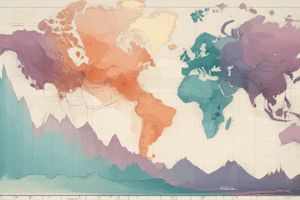Podcast
Questions and Answers
What does a categorical variable do?
What does a categorical variable do?
- Places individuals into one of several groups or categories. (correct)
- Shows the frequency of numerical data.
- Measures numerical values for calculations.
- Lists the values in ascending order.
Which of the following best describes a histogram?
Which of the following best describes a histogram?
- A type of bar graph with vertical bars only.
- A graphical representation of the frequency distribution of quantitative data. (correct)
- A chart that converts percentage data into pie slices.
- A diagram that shows the relationship between different categorical variables.
What is the primary purpose of exploratory data analysis?
What is the primary purpose of exploratory data analysis?
- To evaluate the accuracy of statistical software outputs.
- To examine and describe the main features of the data. (correct)
- To make predictions about future data based on past data.
- To organize data into preset categories without further analysis.
What type of graph would you use to represent the distribution of a categorical variable?
What type of graph would you use to represent the distribution of a categorical variable?
What information does the distribution of a variable provide?
What information does the distribution of a variable provide?
Which field of study has the highest percentage of students?
Which field of study has the highest percentage of students?
What is the total percentage of students in the Arts and humanities and Social sciences?
What is the total percentage of students in the Arts and humanities and Social sciences?
Which visual representation is best suited for displaying the distribution of a quantitative variable with many values?
Which visual representation is best suited for displaying the distribution of a quantitative variable with many values?
What is the primary purpose of a stem-and-leaf plot?
What is the primary purpose of a stem-and-leaf plot?
Which field has the lowest percentage of students according to the data provided?
Which field has the lowest percentage of students according to the data provided?
How are the bar heights in a histogram determined?
How are the bar heights in a histogram determined?
If a histogram is created with a rounding error that adds up to 100, how should this be interpreted?
If a histogram is created with a rounding error that adds up to 100, how should this be interpreted?
What is a common characteristic of quantitative data distribution?
What is a common characteristic of quantitative data distribution?
Flashcards
Individual
Individual
An object or entity described by a set of data.
Variable
Variable
A characteristic or feature of an individual.
Categorical Variable
Categorical Variable
A variable that places individuals into groups or categories.
Quantitative Variable
Quantitative Variable
Signup and view all the flashcards
Distribution of a Variable
Distribution of a Variable
Signup and view all the flashcards
Pie Chart
Pie Chart
Signup and view all the flashcards
Bar Graph
Bar Graph
Signup and view all the flashcards
Histogram
Histogram
Signup and view all the flashcards
Stemplot
Stemplot
Signup and view all the flashcards
Data Class
Data Class
Signup and view all the flashcards
Graduation Rate Data
Graduation Rate Data
Signup and view all the flashcards
Study Notes
Chapter 1: Picturing Distributions with Graphs
- Chapter 1 covers individuals and variables
- Categorical variables are visualized using pie charts and bar graphs
- Quantitative variables are shown using histograms and stemplots
- Time plots are used to visualize data over time
- Data organization is the first step in data analysis
- An individual is an object described by a set of data
- A variable is a characteristic of an individual
Statistics
- Statistics is the science of data
- The first step in working with data is to organize your thinking about the data
Types of Variables
- Categorical variables categorize individuals into groups or categories
- Quantitative variables take numerical values for which arithmetic operations are meaningful (usually with units)
Exploratory Data Analysis
- Exploratory data analysis uses methods to examine data and describe its main features
- It begins by examining each variable individually, then looking at relationships between variables
- Graphs are used as a starting point, numerical summaries are added to analyze specific aspects
Distribution of a Variable
- The distribution of a variable shows what values it takes and how frequently those values appear
- The distribution of a categorical variable lists each category and the count or percentage of individuals in each category
Categorical Data
- The distribution of a categorical variable lists categories and the count or percent of individuals in each
- Pie charts display categorical data by visually dividing up a circle
- Bar graphs display categorical data by using bars to represent counts or percents
Quantitative Data
- The distribution of a quantitative variable shows the variable's values and their frequencies
- Histograms use bars to show the distribution of quantitative data; bar heights represent the data's frequency
- Stemplots are used to display a quantitative data distribution while retaining the values
Histograms
- Histograms are useful for quantitative variables with many values
- The possible values are divided into equal-width classes
- The frequency of observations falling into each class is counted (or converted to a percentage)
- Bars represent the counts or percents in each class, reflecting frequency
Interpreting Histograms
- Histograms' overall patterns and deviations are important
- The shape, center, and variability (spread) of the distribution are descriptions
- Outliers are significant deviations from the overall pattern
Describing Distributions
- Symmetric distributions have mirror-image right and left sides
- Right-skewed distributions have a longer right tail than left
- Left-skewed distributions have a longer left tail than right
Stemplots
- Stemplots are used to display quantitative data, separating each observation into a stem and a leaf
- Stems contain all but the last digit, and leaves contain last digits, displayed in increasing order
Time Plots
- Time plots show data over time, with time on the horizontal axis and the variable being measured on the vertical
- Overall patterns (trends) and deviations are important
- Trends are emphasized by connecting points
- Recurring patterns, like seasonal variations, are also important
Studying That Suits You
Use AI to generate personalized quizzes and flashcards to suit your learning preferences.




